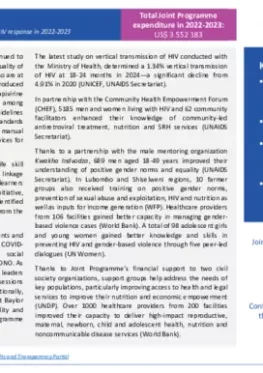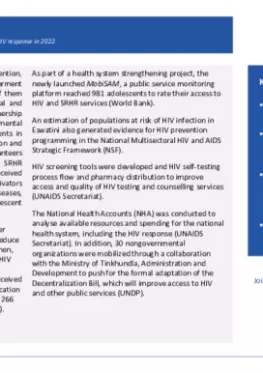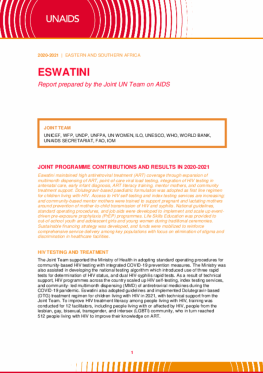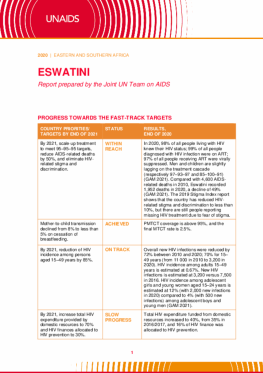In the 2022-20234 biennium, a total of 539 569 adolescents and young people accessed information on HIV, SRH and/or COVID-19 services through digital, social media and social accountability-monitoring platforms, such as TuneMe, NONO. As part of the Baylor Teen Club programme, 28 teen leaders received training on peer support and 24 teen club sessions helped raise HIV awareness among adolescents. Additionally, COVID-19 vaccination was integrated in HIV services at Baylor College of Medicine improving accessibility, sustainability and cost-effectiveness through support from the Joint Programme (UNICEF).
The latest study on vertical transmission of HIV conducted with the Ministry of Health, determined a 1.34% vertical transmission of HIV at 18-24 months in 2024—a significant decline from 4.91% in 2020 (UNICEF, UNAIDS Secretariat).
In partnership with the Community Health Empowerment Forum (CHEF), 5185 men and women living with HIV and 62 community facilitators enhanced their knowledge of community-led antiretroviral treatment, nutrition and SRH services (UNAIDS Secretariat).
Thanks to a partnership with the male mentoring organization Kwakha Indvodza, 689 men aged 18-49 years improved their understanding of positive gender norms and equality (UNAIDS Secretariat). In Lubombo and Shiselweni regions, 10 farmer groups also received training on positive gender norms, prevention of sexual abuse and exploitation, HIV and nutrition as well as inputs for income generation (WFP). Healthcare providers from 106 facilities gained better capacity in managing gender-based violence cases (World Bank). A total of 98 adolescent girls and young women gained better knowledge and skills in preventing HIV and gender-based violence through five peer-led dialogues (UN Women).
Thanks to Joint Programme’s financial support to two civil society organizations, support groups help address the needs of key populations, particularly improving access to health and legal services to improve their nutrition and economic empowerment (UNDP). Over 1000 healthcare providers from 200 facilities improved their capacity to deliver high-impact reproductive, maternal, newborn, child and adolescent health, nutrition and noncommunicable disease services (World Bank).





